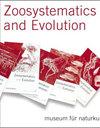来自亚马逊西部的绒毛虫属(Oroperipatus,Peripatidae)的一个新物种
IF 1.6
2区 生物学
Q2 ZOOLOGY
引用次数: 0
摘要
新热带绒毛虫(Onychophora,Neopatida)的多样性被严重低估,特别是在以 Oroperipatus 属为代表的安第斯支系中,其最后一个物种是在 70 多年前描述的。在这里,我们描述了来自厄瓜多尔亚马逊低地的一个 Oroperipatus 新种,从而使厄瓜多尔大陆描述的物种总数达到 7 个,亚马逊西部描述的物种总数达到 3 个。新种名为 Oroperipatus tiputinisp、可通过以下特征组合将其与同属种区分开来:背板交替出现两种不同的初级乳突;初级乳突顶端有四个鳞片等级;第四和第五腿的第五棘垫退化;四个眼上乳突;前乳突偶有退化;雄性的第一对先天性每腿有两个嵴小瘤,下一对每腿有一个嵴小瘤;一些附属乳突的顶端有一个侧面的不发育片。我们还讨论了扫描电子显微镜(SEM)所显示的与其他新翅类(Neopatida)的新的形态异同。本文章由计算机程序翻译,如有差异,请以英文原文为准。
A new species of velvet worm of the genus Oroperipatus (Onychophora, Peripatidae) from western Amazonia
The diversity of Neotropical velvet worms (Onychophora, Neopatida) is significantly underestimated, particularly within the Andean clade represented by the genus Oroperipatus, the last species of which was described more than 70 years ago. Here, we describe a new species of Oroperipatus from the Amazonian lowlands of Ecuador, bringing the total number of described species on mainland Ecuador to seven and in western Amazonia to three. The new species, Oroperipatus tiputinisp. nov., can be distinguished from its congenerics by the following combination of characters: two variations of primary papillae alternated between dorsal plicae; four scale ranks in the apical piece of primary papillae; reduced fifth spinous pad of legs IV and V; four supraocular papillae; occasionally reduced anterior papilla; males with two crural tubercles per leg in the first pregenital pair and a single crural tubercle per leg in the next pair; and some accessory papillae with one lateral rudimentary apical piece. We also discuss novel morphological similarities and differences with other Neopatida genera, as revealed by scanning electron microscopy (SEM).
求助全文
通过发布文献求助,成功后即可免费获取论文全文。
去求助
来源期刊

Zoosystematics and Evolution
ZOOLOGY-
CiteScore
3.50
自引率
5.00%
发文量
34
审稿时长
16 weeks
期刊介绍:
Zoosystematics and Evolution, formerly Mitteilungen aus dem Museum für Naturkunde in Berlin, is an international, open access, peer-reviewed life science journal devoted to whole-organism biology. It publishes original research and review articles in the field of Metazoan taxonomy, biosystematics, evolution, morphology, development and biogeography at all taxonomic levels. The journal''s scope encompasses primary information from collection-related research, taxonomic descriptions and discoveries, revisions, annotated type catalogues, aspects of the history of science, and contributions on new methods and principles of systematics. Articles whose main topic is ecology, functional anatomy, physiology, or ethology are only acceptable when of systematic or evolutionary relevance and perspective.
 求助内容:
求助内容: 应助结果提醒方式:
应助结果提醒方式:


